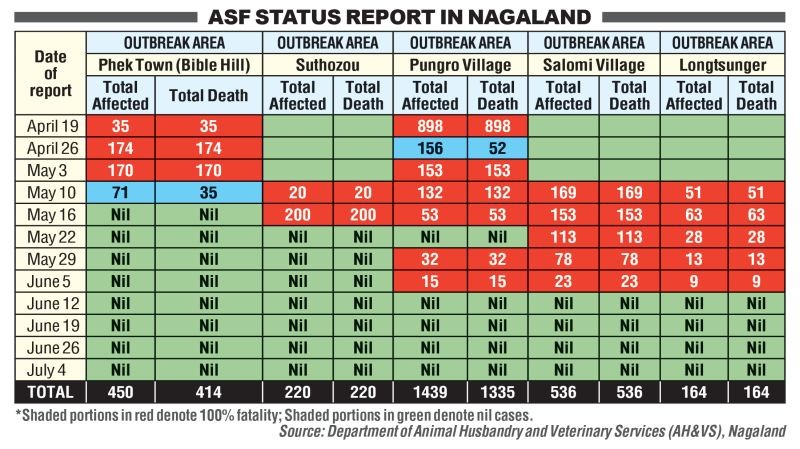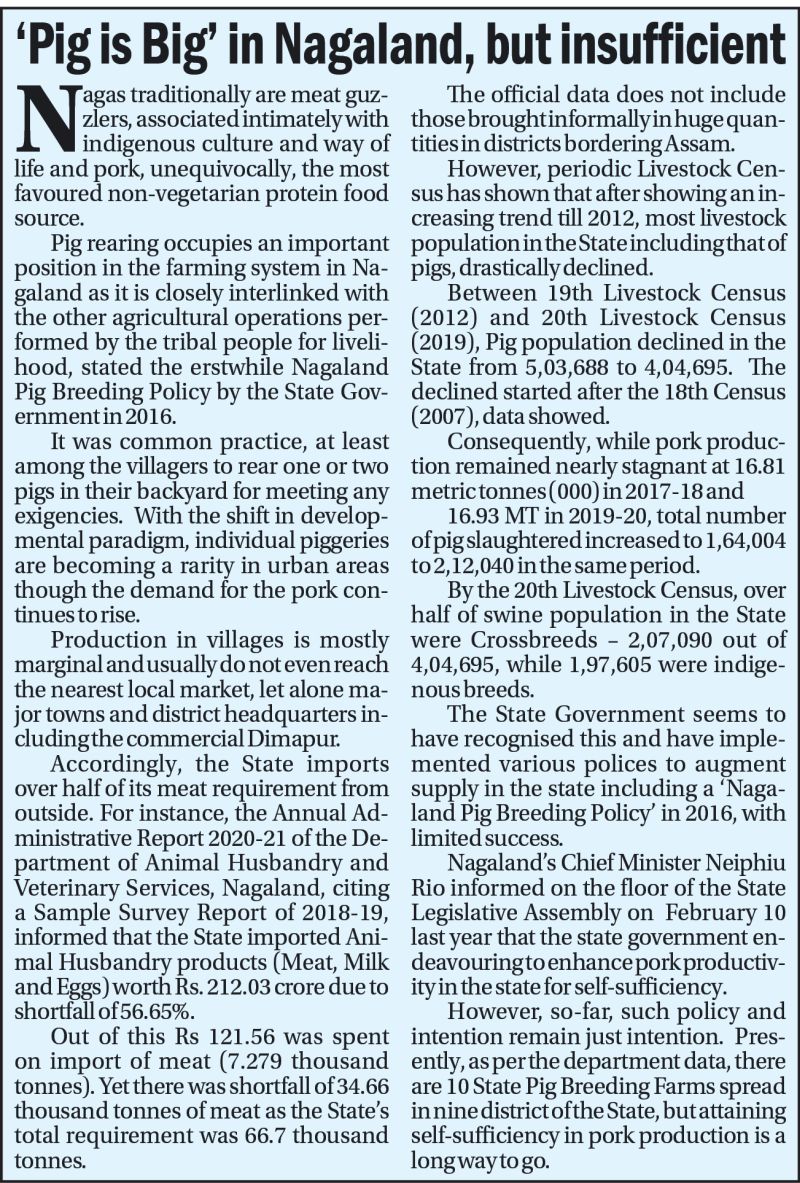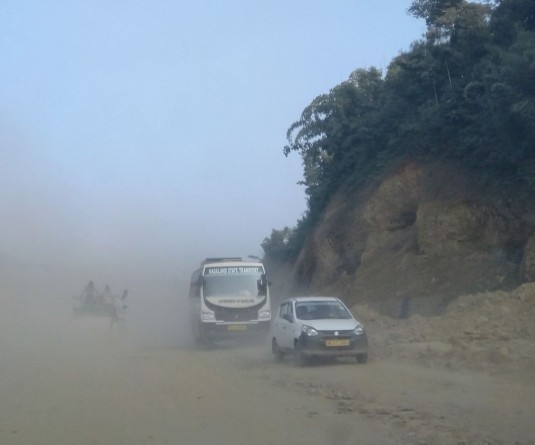
No fresh cases since June 12; State logs 2809 infections, 2669 deaths
Moa Jamir
Dimapur | July 6
Some called it ‘exotic’ while others called it an ‘outside’ disease depending on one’s vantage point. Regardless, official data show that the African Swine Fever (ASF) reached Nagaland in April this year, and though no new cases have been reported since June 12 across the State, the impact has been lethal.
Nagaland officially declared the outbreak of the ASF via a State Department of Animal Husbandry and Veterinary Services (AH&VS) notification on April 17 with confirmation through RTPCR test at ICAR- National Institute of High Security Animal Disease, Bhopal. The samples were submitted from Phek and Kiphire districts.
A radius of 1 Km from the epicentre of the disease outbreak at Phek and Kiphire have been declared Infected Zone (IZ) and a radius of 10 Km as Surveillance Zone with immediate effect until further notice, the department then informed via the State’s DIPR.
Rapid infection and high fatality
According to Food and Agriculture Organisation, ASF is a “viral disease affecting pigs and wild boar with up to 100% case fatality rate.” Such description is verifiable in Nagaland as per a ‘ASF Status Report in Nagaland’ submitted weekly to State’s Chief Secretary and Union Government.
As per a latest status report obtained by The Morung Express through official sources, the first fatalities were reported from Phek Town’s Bible Hill area and in Pungro Village under Kiphire district. The areas were designated as epicentres of ASF.
The status as on April 19 in Bible Hill and Pungro were 35 and 898 cases respectively with 100% fatality.
A week after on April 26, the status in Bible Hill stood at 174 ‘affected’ and 174 deaths; and that of Pungro at 156 cases and 52 deaths.
Till May 3, cases were restricted to the two areas, but thereafter ASF’s epicentre spread further to other areas – Suthozou in Phek and Salomi and Longtsunger villages under Kiphire.
The cases status report on May 10, thus, read: Bible Hill - 71; Suthozou -20; Pungro-132; Salomi -169; and Longtsunger – 51.
Except at Bible Hill, where there were 35 deaths out of 71 infected, all the others areas reported 100% fatality.
At the State Government Pig Breeding Farm in Suthozou, the infection spread further with 200 cases and 200 deaths on May 16 while cases had subsided at Bible Hill by then.
While Suthozou reported ‘nil’ cases thereafter, attributed to complete decimation at the farm according to sources, cases continued to be reported in the 3 Kiphire villages till June 5. (See Table)
Since June 12, no fresh cases have been reported till date, according to the status report on July 4.
Pungro bears the brunt
Overall, so far, 2,809 pigs were infected with ASF, out of which 2,669 or 95.01% died and Pungro village was most affected.
Out of the total, 1,439 or 51.22% of the cases were reported from Pungro, resulting in 1,335 deaths (92.77%). The next was at Salomi village where there were 536 cases with 100% fatality.
The Bible Hill was the third most affected area with 450 cases and 414 deaths (92%).
In Suthozou and Longtsunger (220 and 164 cases respectively), all infected pigs died.
AH&VS combats ASF
The April 17 notification from AH&VS’s was a sort of culmination of nearly a year’s vigil. When ASF cases were reported last year in neighboring states, Nagaland banned the import of pigs on April 28, 2020 which was partially lifted on September 17, 2020, allowing import from Punjab and Haryana.
In April 5 this year, the Department informed of “unusual mortality” in pig population in Mon, Kiphire and Phek districts and issued a set of advisories including refraining from importing live pigs for meat and piglets for breeding purpose from outside without knowing their health status.
Departmental sources, however, informed that cases in Mon district were ‘few and far between’ and more or less controlled. Currently, there are restrictions on sale of pork in the affected areas, particularly, those from outside, in both the districts.
With the official notification of cases on April 17, the department informed that it undertook several control measure to combat the disease.
As of June 28, the premises of 198 backyard farms were disinfected while clothing and bedding materials were destroyed in 101 premises. A total of 29.2 quintals of animals feeds were destroyed, as per the department.
On June 24, AH&VS Director Dr Budhi Lama said while the cases were nil for two weeks, the department is not letting its guard down and constantly monitoring and sending weekly status reports.
When updated on July 5, he informed that while the ASF is now seems to be ‘under control,’ based on the ‘nil’ reports for nearly a month, the department still ‘needs to carry out surveillance for more weeks to make the State ‘ASF free.’
Only the central government can declare the State ASF-free based on weekly reports, he added.
With most villagers practicing backyard farming by rearing two or three pigs for meeting any exigencies, the impact on marginal farmers would be huge necessitating relief measures from the State Government.
According to the sources, the State Government has not provided or had announced any such measures for the affected pig farmers so far.
Chronology of ASF:
• April 28, 2020: Nagaland Chief Secretary issued ban on import of pigs from outside
• September 17, 2020: Ban Partially lifted
• April 17, 2021: ASF outbreak in Nagaland officially notified
• April 19, 2021: First Status Report from two areas
• May 10, 2021: Infected areas spread to 5 areas
• June 5, 2021: Last report of infection and deaths from all areas
• June 12, 2021: ‘Nil’ cases from all affected areas
• July 4, 2021: No fresh cases for nearly a month






